We started the long awaited Map Mathare on Monday, 6th December, 2010.
Before that we had a forum on Wednesday, 1st December, where teams from Kibera presented what they did and talked about the plans for Map Mathare. The forum was a success as around 130 people showed up and the response we got made us believe it’s possible.
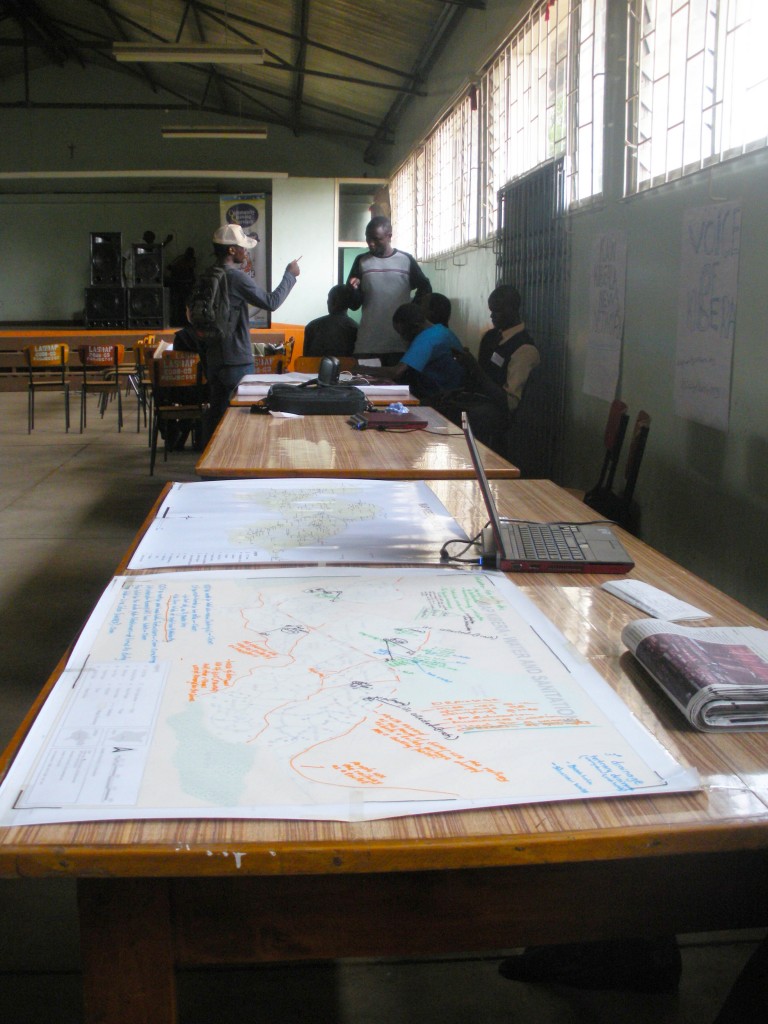
Stands for each of the programs
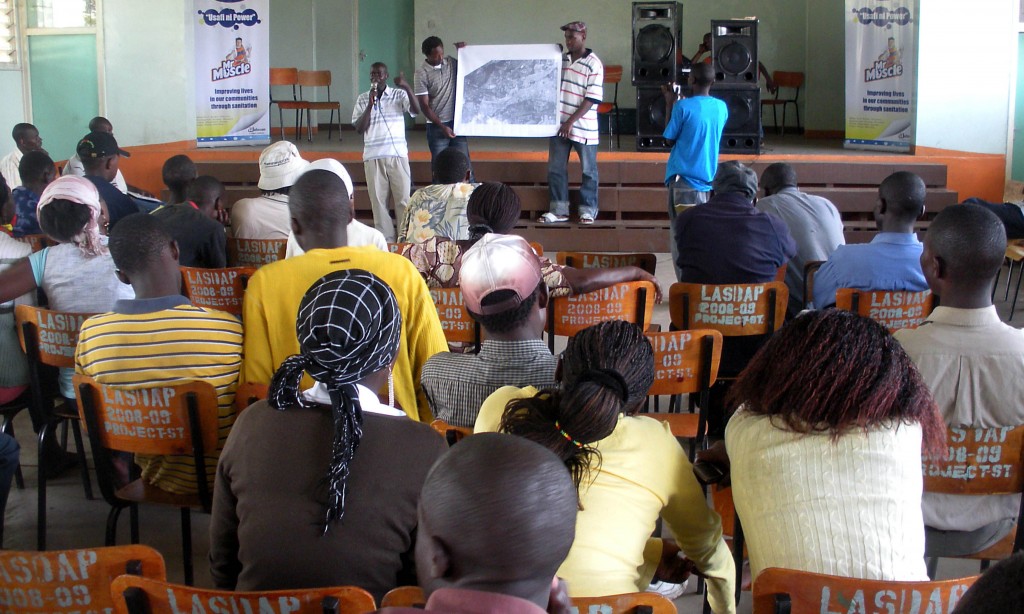
Simon Kokoyo explaining the importance of Map Mathare
Sailing on the success of the forum we stepped into Mathare as said on the 6th. Each team presented, this time about more theoretical approaches to each of the three programs. Even though only 5 people showed on time we ended up (thanks to Simon Kokoyo) with 46 participants on the first day. I had a hunch we might see some of their friends the next day.
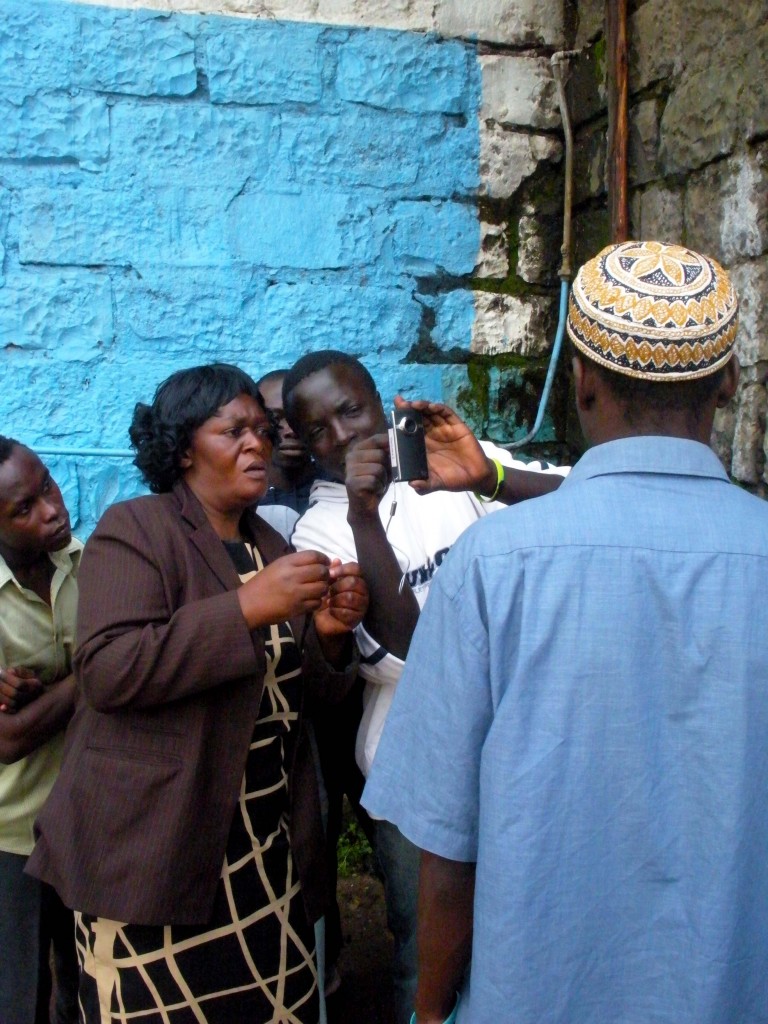
Steve from Kibera News Network in action
And I was right as around 70 people showed up on Tuesday, 7th December, for the practical part – GPS and video data collection. The most surprising of all? Everybody was on time! We had 15 people from Kibera and two helpers from Mukuru slum to handle the swarming population of would-be mappers and reporters. We divided people into teams representing different villages of Mathare and sent them out on a data collection spree. The day went smoothly except for one incident where a team from Mathare Village 1 was attacked by a drunken man but the team members from Village 1 managed to control the man.
Wednesday, 8th of December, was reserved for data editing but an unfortunate thing happened – a blackout. So instead of having almost 100 people waiting around for the generator to be set up we sent everybody out to the field again to collect more data.
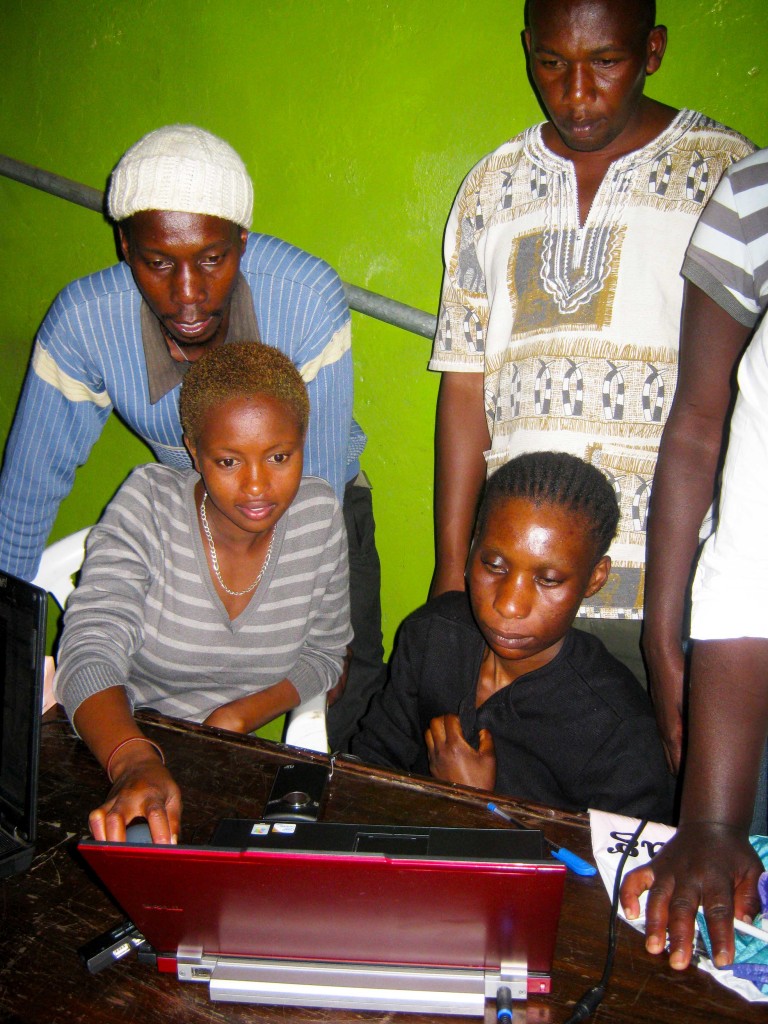
Joe from Kibera News Network (white cap) in action
GPS data collected the first week:
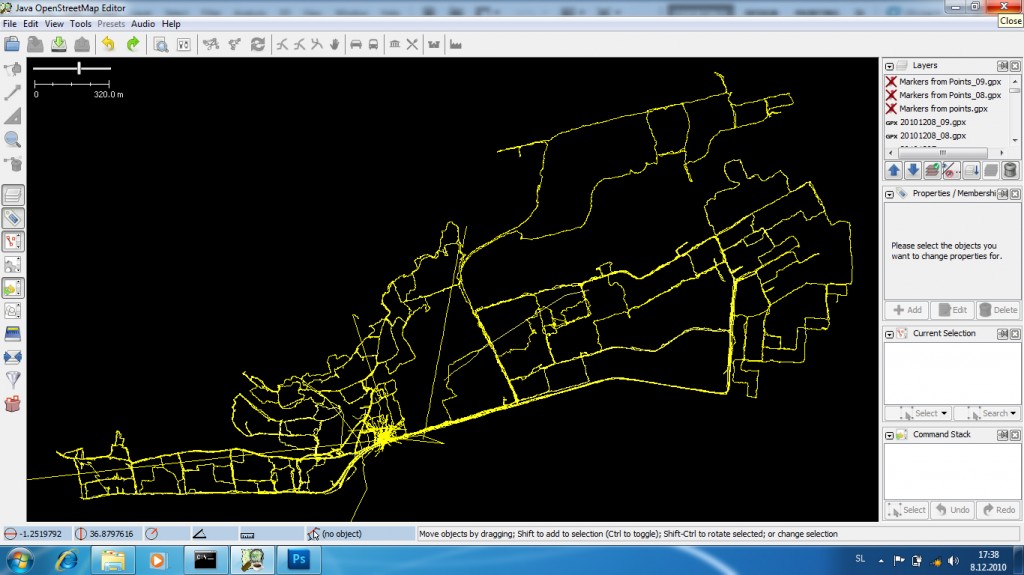
Mathare tracks
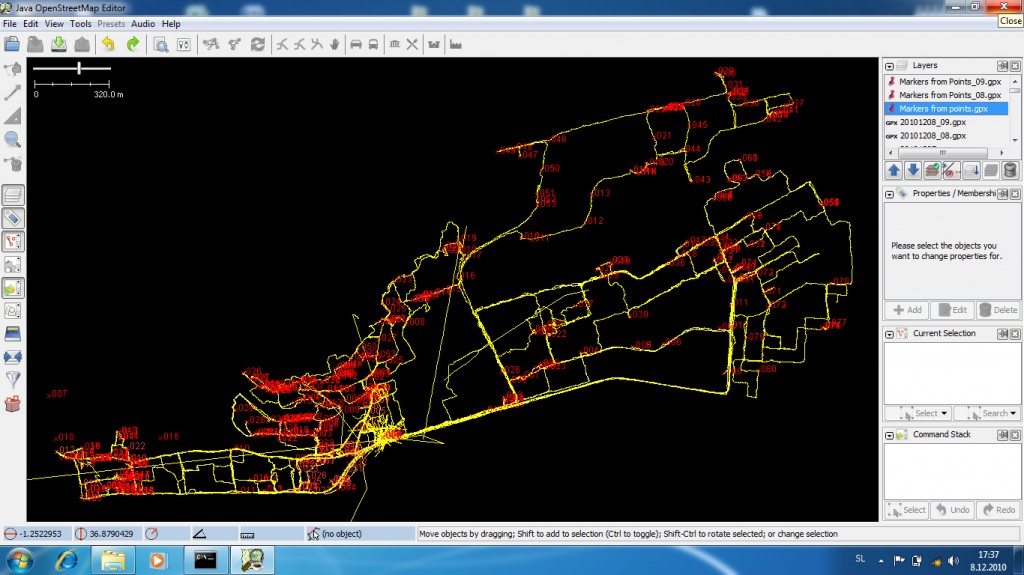
Mathare tracks with points
We also collected couple of hours worth of video footage which we’ll use to make a documentary of the first two weeks in the field.
Lessons learned on the first week:
- Divide people into teams representing different villages. Divide them further into mappers, video and voice members and, if necessary, divide them further into smaller teams of mappers and video.
- There is a need to divide people so that some go to the field in the morning while the others work behind the computer. Map, voice and video editing should take place on different days.
- Find a second venue as one is too small for the amount of people we have at the moment.
This week, 13 Dec – 19 Dec, is round two.
The biggest slums in Nairobi (like Kibera and Mathare) usually consist of different villages. That is why before we started working in Mathare we had to determine where these villages are located.
This was/is important for many reasons:
- Determining the area. By locating the villages of the slum we outlined the area of Mathare.
- Planning purposes. We use these villages to plan how different teams will operate. The idea is that each team maps its own village, bringing me to the next important thing:
- Each village needs to be represented. A person coming from a certain area knows that area best.
- And the last but not least – security. There is no way that a person, specially coming from outside, can freely walk the streets of Mathare.
For the purpose of determining the village boundaries we printed out the satellite imagery of Mathare, which was donated to us by the American Association for the Advancement of Science. After that I gave the satellite imagery to Simon Kokoyo form COOPI and Reality Tested Youth Program. He walked around the slum and talked to elders, who helped him determine the village boundaries of the slum by drawing them on the printed satellite imagery.

Drawn villages of Mathare
I uploaded the satellite imagery into JOSM and digitized the boundaries according to the drawn image.
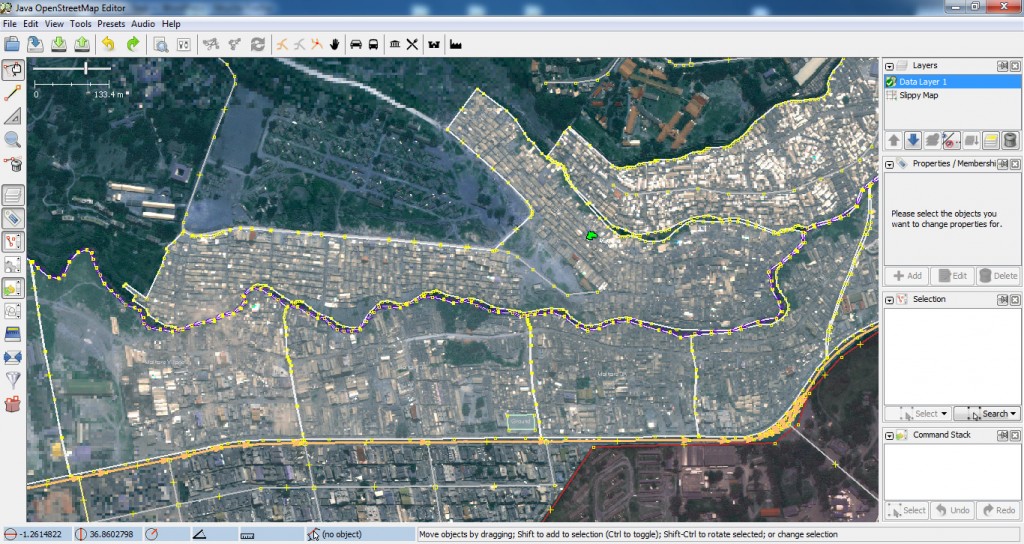
Digitizing in Java OpenStreetMap Editor
And HERE are the villages of Mathare and Mathare slum area in OpenStreetMap – the borders have already changed couple of times :)
To follow up on what Mikel wrote in his post called Map Kibera has become a Research Subject. Happily!, this is the situation on the ground at the moment.
While Mathare is approaching with fierce speed the Kibera teams are working hard to set up the Trust, struggling to create their basic visions and missions, developing their personal goals, thinking of ways to get their work across into the community (something that hasn’t been done yet) and preparing to train others. Working on two fronts is going to be, well let’s say challenging.
But how much excitement and effort can we really expect from our teams to do something we feel is good, maybe even good for them? When asked what their vision, mission and goals are all I hear is the mantra they picked up along the way about how they want to contribute to open data and sharing of information and being the eyes and ears of the community etc. But do they really know and understand what this means or are they just repeating something they were told is good? After all they are going to be the messengers to their communities and based on their messages the communities will react. We say we’re doing this to see how open data can influence the marginalized communities to better advocate upon themselves. But what do they want out of this? I know people have been trying to answer these questions before but it’s somehow different when confronted with faces in front of you, it’s much more personal.
On our meetings I challenge them and ask them what their personal goals are. What do they want and expect from the programs? Do they want to volunteer in these programs forever? What are they doing to distinguish themselves from the thousands (if talking of You Tube millions) of others who are doing the same? When asked this question they usually answer that they want to get paid or get paid jobs, be famous, travel the world etc – these are real dreams, real life goals. And aren’t we doing this so we can empower members of this community to advocate upon themselves and to have a better chance when competing with the luckier and the richer comrades?

Voice of Kibera team
That is why we’re now trying to make them look at what they are doing as a business, a marketing of their skills. They need to sell their ideas and their talent. They have the opportunity to do that through the programs they are involved with. They can still be the eyes and ears of the community and still influence change but they also need to think about the sustainability of the programs which will be achieved only if they are satisfied with what they are doing.
So the discussion in the past week has been how to raise awareness about Map Kibera’s programs while putting the skills and ideas of the three groups on the market.
The Map Kibera teams are planning several activities to achieve this goal:
The Mappers will raise awareness through Atlas distribution. They plan to do this through a publicity gaining “Atlas launch†to which they plan to invite government representatives, NGOs, UN representatives, community leaders etc. They will ask for small contributions which will be used to print more maps. They also want to distribute the Atlas and hold lectures in schools of Kibera, identify public places to post maps, start public discussions regarding the data collected by organizing community meetings, and they even plan to start a discussion regarding naming the streets in Kibera. Last but not least they want to re-do (update) the map.
The video team wants to start weekly public screenings to showcase their talent and present their work to the community and hopefully start discussions around the stories and events they collect.
Voice wants to set up stands and distribute flyers and stickers to publicize the number.
All of them want to train others. It’s serious stuff and hopefully something good comes out of it! And while the Kibera teams are thinking hard about all these issues, Mathare is like a bee hive, full of expectations, ready to go to the moon. The venue for the forum is reserved and people are being invited.

Mathare
The forum will take place on December 1st and will last about half a day. We’ll start with introductions from Rose and Simon (CCS and COOPI). CCS will than facilitate “mapping with the feet” , a participatory exercise that asks participants to place themselves within a room with relation to their geographical position in the community in question, to show the participants what mapping is in the simplest of way. The Kibera teams will then present what they did in Kibera and invite people to the stands where they will showcase the equipment and methods and answer more questions. In the end we will open the stage for discussion.
Anyhow it’ll be interesting couple of months. At the moment there are more questions than answers, but hopefully by the end the tide will shift.
Oh… by the way, Mikel and Erica left. Sorry for us.









